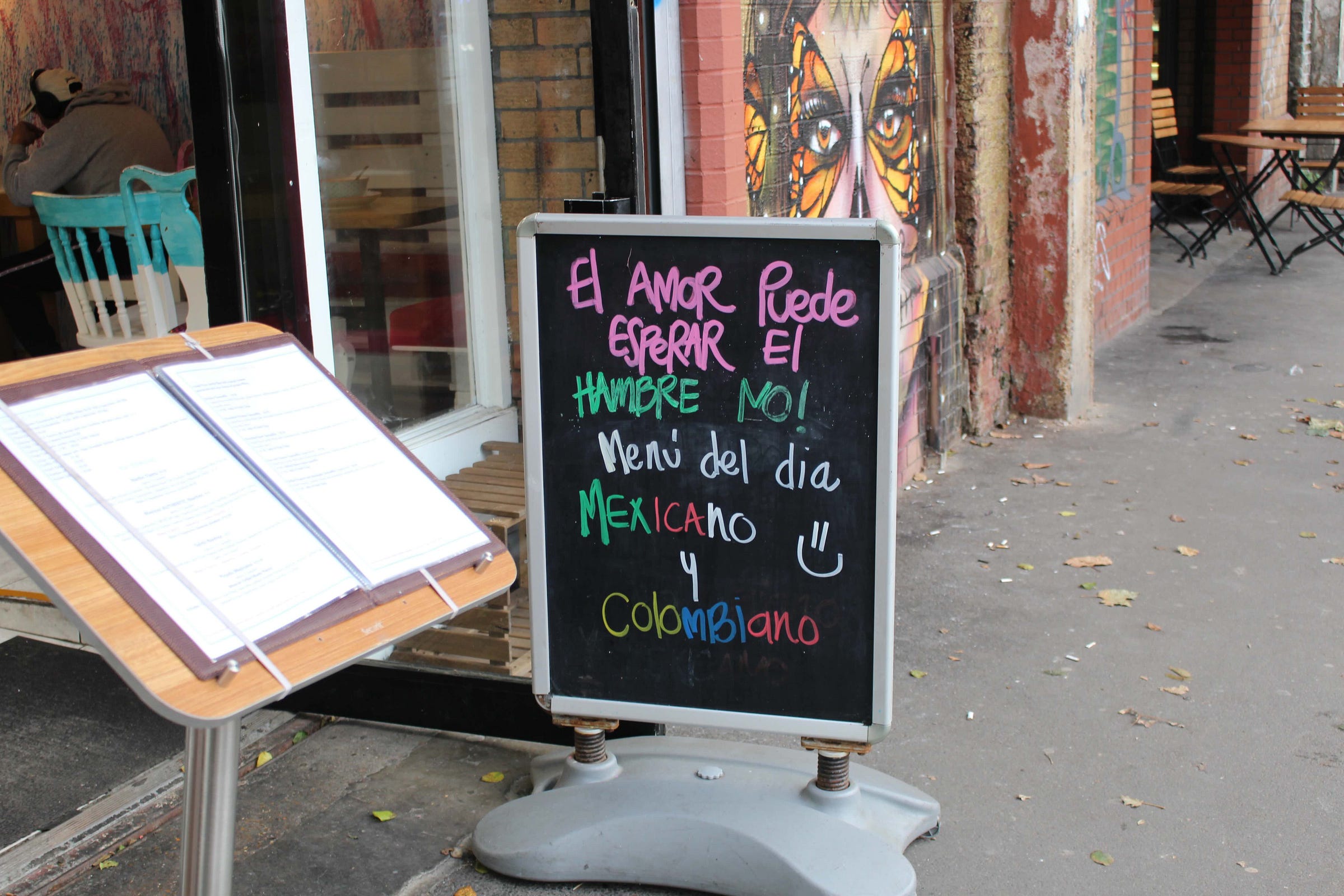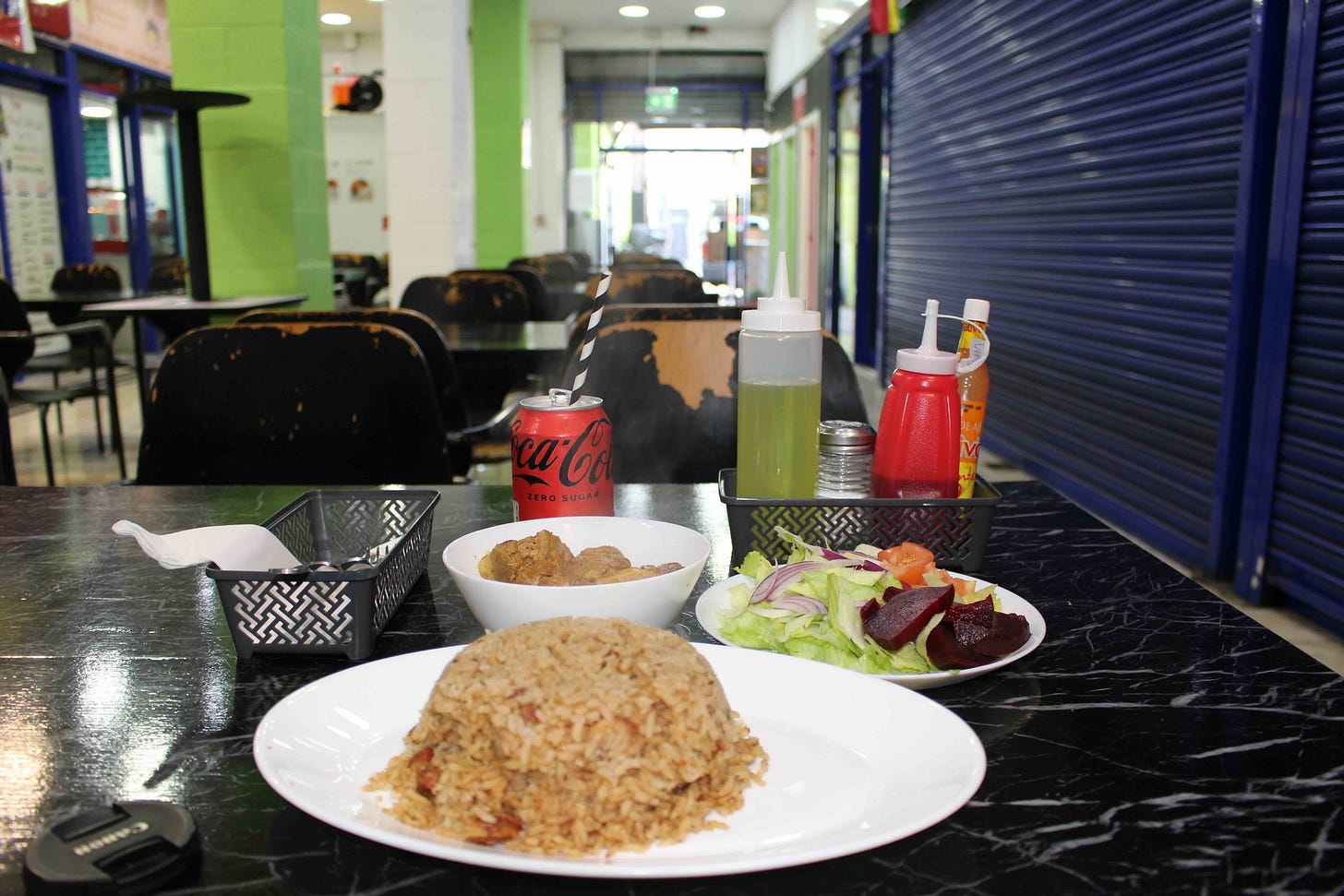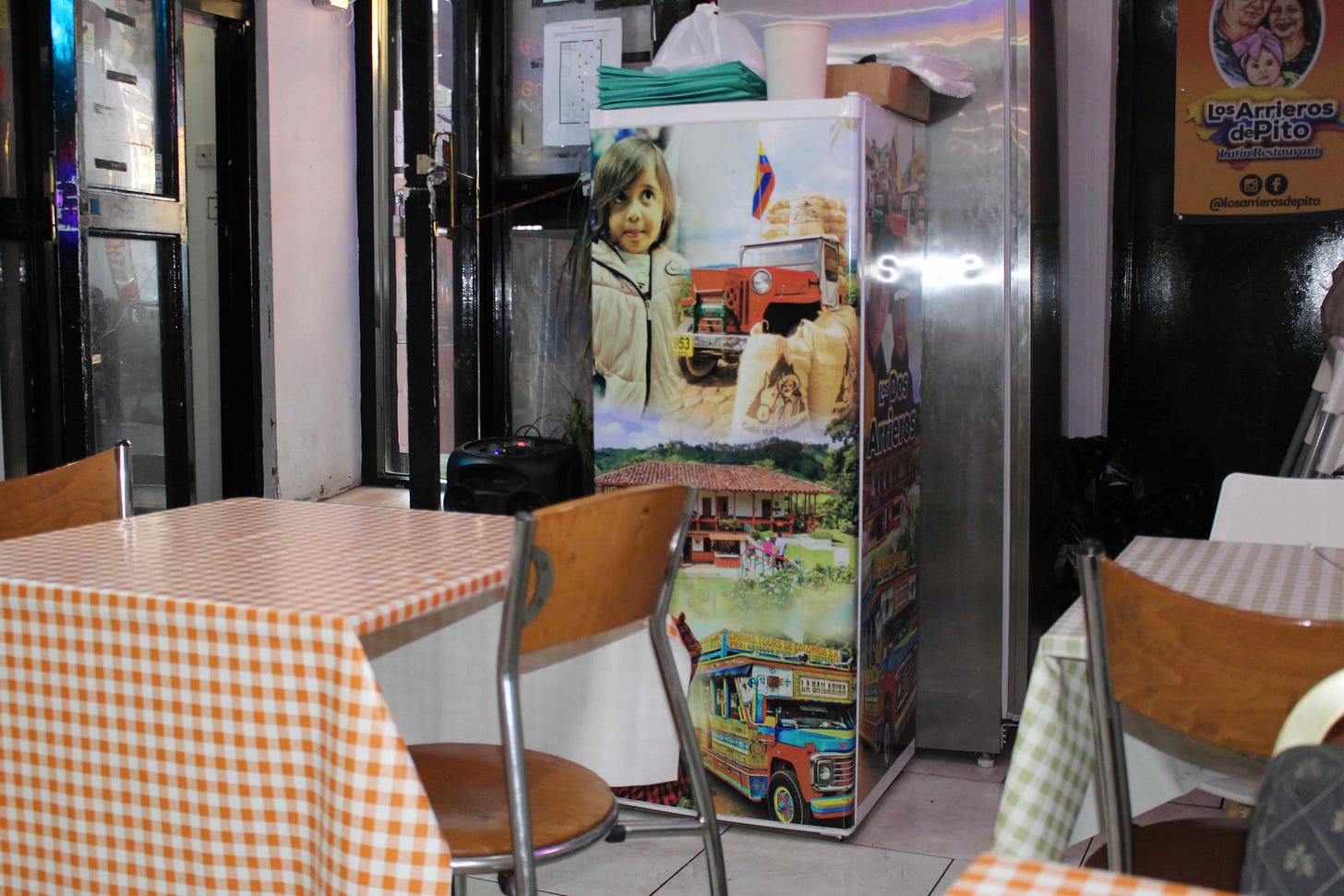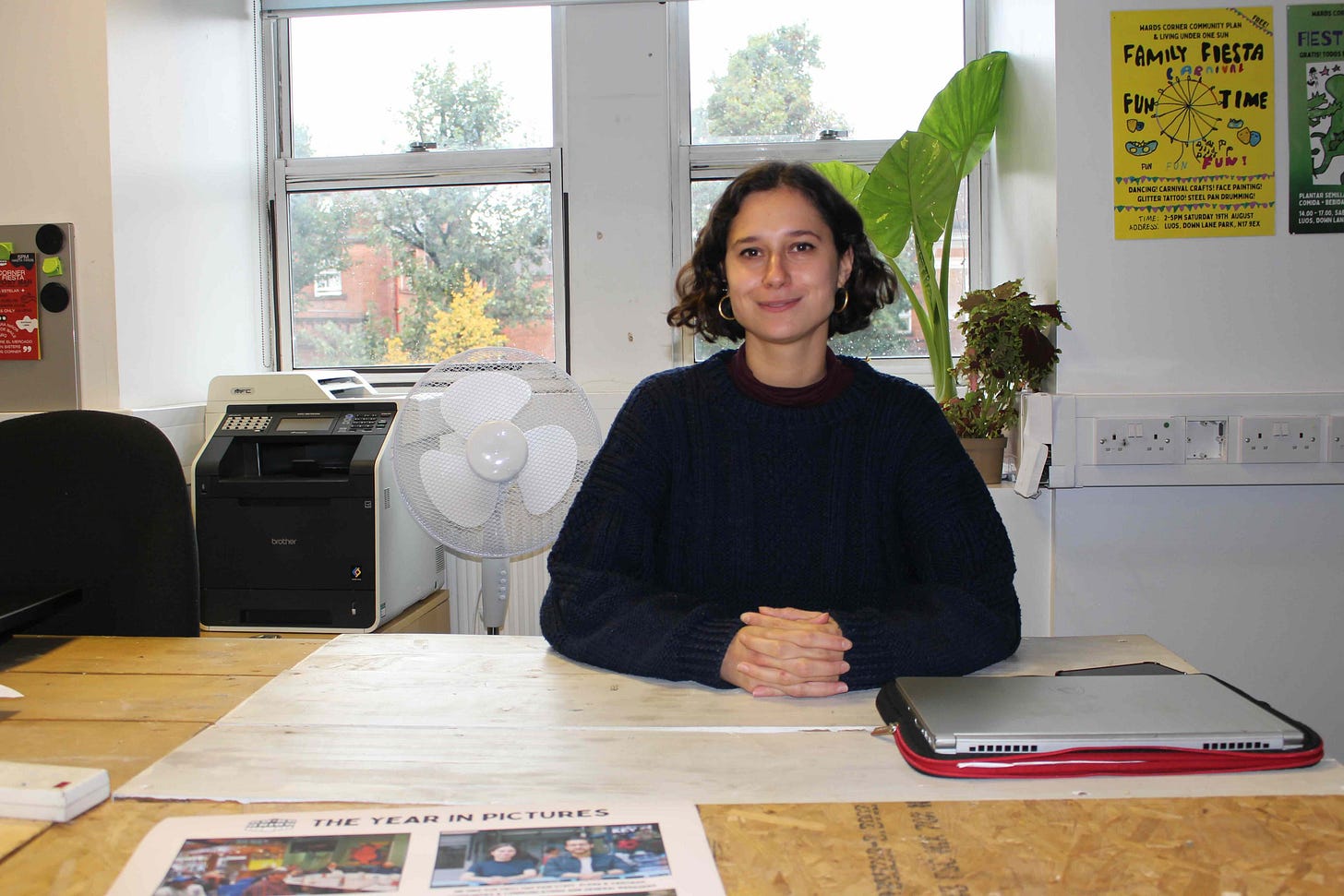'Love Can Wait. Hunger Can't!' How London's Latin Communities Rebuilt
After Latin Village, a migrant community’s struggle for informal spaces to create and live on both sides of the river. By Martin Francisco Saps. Plus, a special Six of One by Jonathan Nunn.
Welcome back to Vittles Restaurants. Today’s reported feature is by Martin Francisco Saps, who has previously written on kosher food in Stamford Hill for Vittles. Martin reports on the fate of London’s Latin communities and their restaurants, as major developments have displaced them during the last decade – in both the north and south of the city. This is free to read for all subscribers.
Beyond the paywall, there’s a bonus Six of One: Six Latin restaurant recommendations in south London from Jonathan Nunn.
A Vittles subscription costs £7/month or £59/year. If you’ve been enjoying the writing, then please consider subscribing to keep it running. It will give you access to the whole Vittles back catalogue, including all restaurant recommendations and recipes.
'Love Can Wait. Hunger Can't!' How London's Latin Communities Rebuilt
After Latin Village, a migrant community’s struggle for informal spaces to create and live on both sides of the river, by Martin Francisco Saps.
The week after I moved to London in September 2019, I found myself wandering the streets of Tottenham looking for something to eat. The Spanish-language signs advertising money transfers and coffee drew me into an arcade-like market called Latin Village, or ‘Pueblito Paisa’ as it’s known locally. Inside, traders joked with one another, families of six or seven across three generations sat in front of massive plates of fried pork with plantains, calling out to the kids running around the halls. ‘Tengan cuidado!’; ‘Ven aquí!’. It felt familiar, like a place where my brother and I would have yelled at the TV in Spanish as Diego Forlán led Uruguay to the 2010 World Cup semi-finals.
Two years later, following the Covid lockdowns, I went back to Seven Sisters station looking for the market.
‘Y el mercado?’ I asked a young man wearing light jeans and white Air Force 1s, a design shaved into his hair.
‘Sigue cerrado’, he answered.
Hadn’t the restrictions been lifted? I thought. Surely most places were open again.
In the years between these two encounters, the fifteen-year-long campaign to save Latin Village had garnered national media attention. At the heart of the campaign was the Seven Sisters Market Tenants Association (SSMTA), an organisation of market traders who relied on the market to survive in London.
Beyond a cultural centre, the market was an economic incubator. Those who wanted to take the plunge into self-employment could set up a kiosk – starting at the minimum rent of £75 per week – in a space with guaranteed footfall. Without a community space, there are fewer opportunities for locals to find work, send remittances and packages back home, or simply have a good time.
The robust campaign had a concrete demand: to stop Transport for London (TfL), the building’s owner, from selling it to Grainger, a developer which planned to turn the site into 190 build-to-rent flats. Instead, they looked to bring in a community plan for the area which would guide future development. In August 2021, Grainger withdrew their development plans, blaming ‘rising costs’ and the impact of the campaign.
But by that point, the damage was done. One morning in March 2020, the traders showed up only to find all of the doors locked and a closure notice – on grounds of health and safety – posted on the front door. David McEwen, an architect formerly based at Unit 38 in the market, helped write the community plan. ‘The health and safety concerns were legitimate,’ he tells me, ‘[but] it should have been the responsibility of Transport for London to have addressed them historically.’
‘For us, the market’s closure was catastrophic,’ says Vicky Alvarez, a Colombian former trader, businesswoman, and organiser who, together with her daughter Stefania, helped lead the campaign. Alvarez, a serial entrepreneur, was ultimately able to relocate, but most former traders have been working as cooks or cleaners at other local businesses.
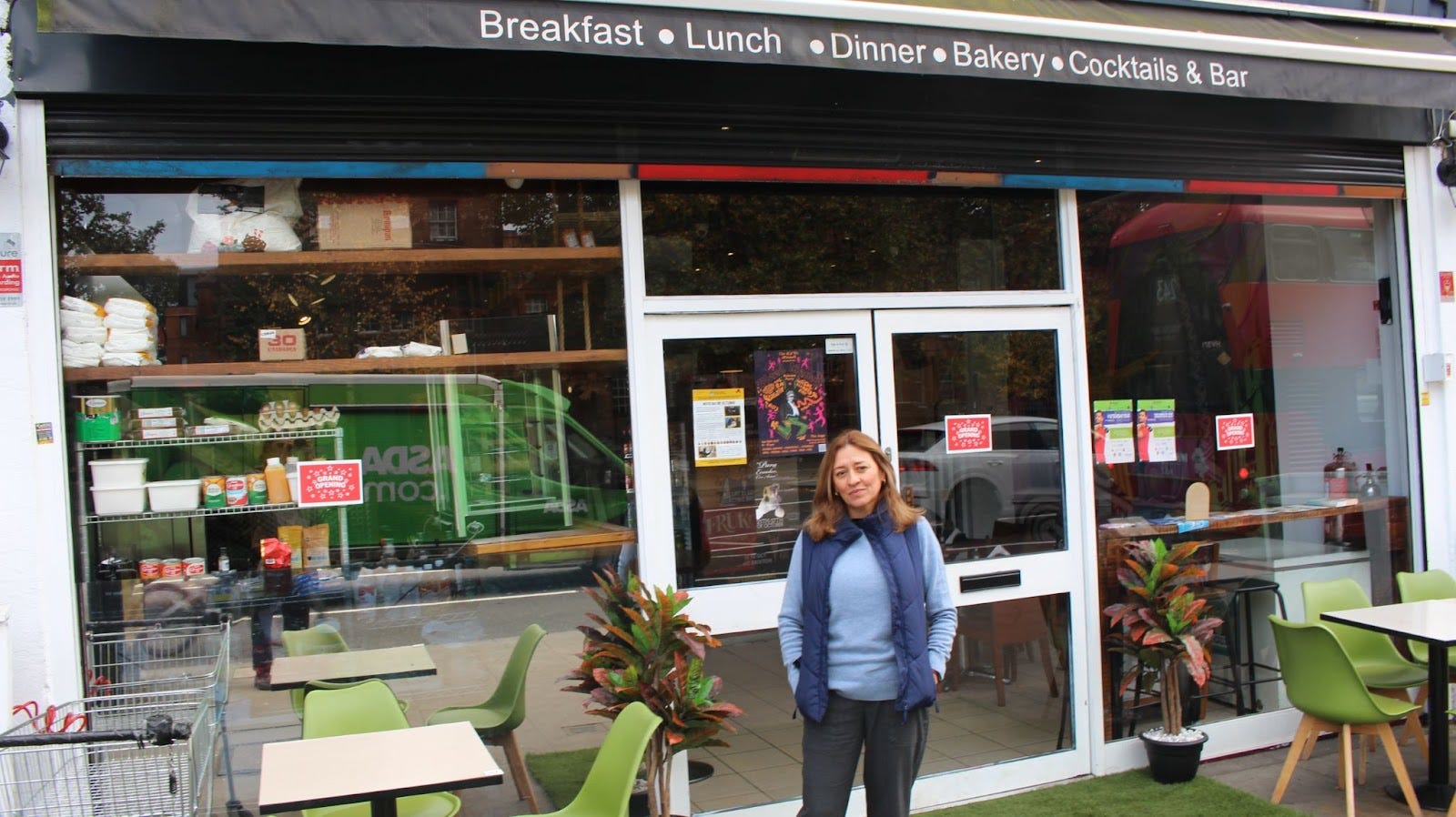
Despite receiving some compensation from TfL and business support grants, the closure of Latin Village left traders like Daniel Martinez of Martinez Butchers without business for almost half a year. In that time, Martinez had to find, fit out, and move his butchery to a new spot on the High Road, something which cost tens of thousands of pounds. He was one of the lucky ones. Originally from Colombia, Martinez has lived here for over thirty years and speaks English well. He was able to afford the up-front costs for taking on a formal lease. ‘For us, the change worked out well in the end, but there’s a lot of people who don’t have a space. It’s very hard.’
Martinez agrees that the change has been seismic. ‘Now it’s just a place of business. Before it was a community. You would come, have a coffee, chat, talk about life. It was therapeutic,’ he explains. ‘Now you just come, work, buy, and you leave.’
Today, Latin Americans are one of the fastest-growing migrant populations in the UK, with new restaurants and businesses popping up across Tottenham and a number of south London neighbourhoods, such as on Old Kent Road and in Elephant and Castle (two other Latin strongholds in the city). Flip through the pages of Mundo Latino, the self-proclaimed ‘most read newspaper in London’, and you’ll find dozens of Spanish-language (and some Portuguese) adverts for nail salons, restaurants, weight loss treatments and CV editing. And now that Latin Village market is set to begin its phased reopening, many Londoners hope summer 2025 will usher in a new, sustainable future for the Latin community in the north and south of the capital. But before we look too far ahead, let’s examine how we got here in the first place.
According to a 2016 report, nearly 145,000 Latin Americans – who first arrived from Colombia, Brazil, and Ecuador in the 1980s, but have increasingly moved from Central America – call London home, representing a growing part of the city’s cultural fabric. Unlike Latin America’s diasporic capitals – New York, Miami, Barcelona – London is off the beaten path. But across the city, the community’s markets are cultural embassies, providing migrants with essential services like money transfers, shipping, cultural foods and mutual aid. They also foster a sense of community. Santiago Peluffo, an Argentine activist recounts that ‘You would go [to Pueblito Paisa] in the afternoon to drink a beer and eventually it turned into a party that would go on until whatever hour. It was incredible.’ Peluffo mentioned the location’s legendary Latin supermarket – colloquially known as the Super-Supermercado – where late-night conga trains would travel through the store’s aisles.
Eight miles down the A10, Elephant and Castle’s Latin community is facing a similar struggle to preserve their spaces. The Elephant and Castle shopping mall, built in the 1960s, had long been a community hub for migrant communities: originally it housed Afro–Caribbean businesses, but since the first Colombian-owned business opened in 1992, it became the largest conglomeration of Latin-owned businesses in the city. Since then, the area has transformed rapidly. The Elephant and Castle Town Centre masterplan included not only the demolition of the shopping centre, but also the nearby Heygate and Aylesbury Estates. Since the loss of the Heygate, the area – with countless new builds, building sites, and blaring sirens – has the chaos of an urban junction coupled with ersatz new developments in the new London Vernacular style, including, on one side, the University of the Arts, a structure that could be mistaken for an East German administrative building.
Cesar Quintero, owner of the local La Distriandina (and a neighbourhood celebrity) has been in Elephant and Castle through the changes. His restaurant, cafe, and dance hall has been located under Arch 6 on Elephant Road for over twenty years. It shared a wall with the shopping mall, but was spared. Community centres like the shopping mall were ‘landmarks,’ he says. ‘People [from Latin America] coming to London for the first time were told “I’ll meet you in Elephant” or “See you at La Bodeguita [one of the mall’s most popular restaurants]”’.
Over the last decade, Latin Elephant – a local charity – has led the campaign to secure rights for the mall’s traders in the face of the centre’s closure; despite being demolished in 2020, the traders were able to relocate, with discounted rents, to within a five-minute radius of the former site, keeping the local community intact. The Latin Elephant campaign didn’t succeed in stopping the demolition and redevelopment of the site, but it did give the community a seat at the table. The council’s approach was the same here as in Tottenham. ‘The council didn’t recognise what migrant – principally Latin American businesses – were bringing to the area. They thought, “These areas appear run down … there is inequality and deprivation,”’ McEwen says. They were quick to promote regeneration as the solution. In the case of Latin Elephant, accepting that regeneration and development would happen allowed them to secure benefits for the tenants.
For Peluffo, it’s robust united front – led by academic and activist Patria Román-Velázquez – made it successful overall . ‘On 24 September 2020, the mall closed. On the 25th, the residents were already setting up their new businesses,’ Peluffo told me. The tenants, which included Ana Castro Boutique and Black Cowboy Coffee, were given units at the newly constructed Elephant Arcade and Castle Square (a temporary structure next to Elephant Park, which will itself close once the area’s masterplan development is complete).
At the same time, the reduced footfall means that many have found it difficult to attract customers. Quintero points across the road to a small unit with a red street-facing sign that reads ‘Coma y Beba’. “See that place? It used to be called La Bodeguita, the most popular restaurant in the shopping centre. Now no one goes there. They [the council] put them there to run them out of business. So that they wouldn’t make more trouble.’

If Elephant and Castle is fighting to preserve its Latin community, other places are welcoming its refugees. The community now survives along the arches under the railway stretching down Walworth Road, which are owned by The Arch Company. The Arch Company have a reputation for spiking rents and driving long-timers out; their new landlords, backed by property investment giants Blackstone and Telereal Trillium, now own most of England’s railway arches, which they purchased en masse from Network Rail for £1.46 billion in 2019.
One of these businesses now operating from these arches is Los Arrieros de Pito, run by Marta Agudelo Villa and Jose ‘Pito’ Fajardo Jaramillo. Pito is known for his eccentric Instagram and TikTok presence, where he frequently appears, in a Colombian cowboy outfit, talking about Colombian style, culture and food. Pito and Marta’s son Walter proudly showed me around the restaurant, pointing out coffee bags and murals of pimped-out school buses on the wall. ‘We want people who come here to feel like they’re in Colombia.’ On the other wall are pictures of Pito with UK-based Colombian soccer players, like Arsenal youngster Alexei Rojas and Faustino Asprilla, the legendary former Newcastle striker – both of whom regularly eat there.
For all the pitfalls (many yet to come) of development in the area, Latin Elephant’s Up the Elephant campaign has made the community a legitimate stakeholder in the eyes of the council. And remaining in the area has also had the unintentional effect of bringing Latin food to a new clientele. In addition to bringing in a growing community of Central American migrants, Pito’s fame has registered with the increasing number of East Asian international students looking for new foods, something echoed by many business owners in the area. Walter tells me that London’s rich foodscape has influenced Pito’s menu as well: their famous Picapollo dish – fried chicken with a spicy cajun batter – is actually a Dominican recipe, from the previous owners La Barra. For now, the neighbourhood’s change has spread a London-minted Latin Fusion cuisine beyond the community.
Over on Old Kent Road, a multitude of new Latin fusion restaurants have popped up in the past few years: Salteñas Martin, which opened in 2023, serves Bolivian salteñas during the week but features a Mexican menu on weekends. Just up the road, past the Dominican barber shop and the Honduran restaurant, is El Socavon, a cocktail lounge with Mexican, Peruvian, and Colombian decorations. It’s advertising an upcoming Argentine Cumbia Villera event and live music every weekend. Since 2018, La Placita in New Cross Gate – a small arcade of around twelve restaurants, tucked away in a small alleyway – has become an up-and-coming home for community businesses, culture, and events. If Latin Village and the shopping centre are now nostalgic cultural icons, Old Kent Road may be where you can find the community’s future.
Since my first interview in October, a lot has changed. In Tottenham, arcades continue to pop up in subdivided spaces on the A10 high road; Las Delicias de Juancho, run by a former Latin Village trader, shares space with a juice shop and clothing repair shop. I ran into Quintero in Elephant and Castle, and he told me that La Distriandina is opening a new location on Tottenham High Road in March 2025.
When we spoke, she was sitting next to Elena Escalante, a passionate and energetic Spanish filmmaker recently hired by the Wards Corner Community Building Society (CBS) to engage the community . Despite the fracture of the last five years, it appears that construction has been moving at pace and the community will come back better. Having recently secured a partnership with Haringey Council and Places for London, the Wards Corner Community Building Society (CBS) – with a new board – is rallying to open the soon-to-be completed temporary market, the first step towards fully re-establishing it as a community space for the long-term.
Alvarez, together with the SSMTA, is still fighting for compensation to cover the time the market was closed and the costs of fitting out the new market space. McEwen estimates the total amount could be in the millions. Although Martinez is satisfied with his new high street location, he’s confident that in time he’ll also open a small side-business in the market. He misses the atmosphere. And he wants to help others. Martinez understands that markets aren’t just places for work; they’re economic and cultural incubators whose value is too often overlooked by developers, councils and private equity firms.
Bringing the market back to the vibrant atmosphere it once was will take time. But the market’s summer 2025 reopening will set a precedent for London; an instance in which communities of traders – on both sides of the river – have taken charge of development in their neighbourhoods. It’s that sense of mutual aid and perseverance that has made the community prosper throughout the city, and to be able to better rebuild.
I’m thinking about the dozen or so people that I met while researching this article and what they’ve shown me. ‘Immigrants adapt,’ says Peluffo, whose years of work with Colombian colleagues during the campaign inspired him to try life in Medellin. ‘We know how to find opportunities everywhere. That’s what makes us so strong.’
Clarification: An earlier version of this article didn't mention the recent partnership between Ward's Corner CBS, Haringey Council, and Places for London.
Six South London Latin American Restaurants to Try, by Jonathan Nunn
Ecuadorian, Bolivian, Salvadoran, Venezuelan and Colombian lunches



